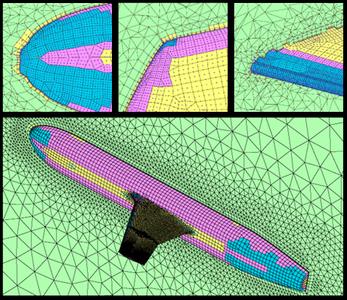
Free Download Cadence Design Systems Fidelity Pointwise 2022.2 hotfix 2 | 1.2 Gb
Product:Cadence Design Systems Fidelity Pointwise
Version:2022.2 hotfix 2 with Tutorials
Supported Architectures:x64
Website Home Page :www.pointwise.com
Languages Supported:english
System Requirements:Windows *
Size:1.3 Gb
Pointwise announced the latest release of its Pointwise 2022.2 (hotfix 2) is one of Cadence Design Systems' premium software tools used for grid generation and preprocessing for computational fluid dynamics (CFD).
Fidelity Pointwise 2022.2 - What's New
Fidelity Pointwise 2022.2 presents variety of new features and enhancements to efficiently generate meshes for fast, high-fidelity CFD computations. In particular, we want to showcase for you High-Performance Grid Elevation, Automatic Surface Mesh Improvements, and Improved Efficiency for Unstructured Block Smoothing.
High-Performance Grid Elevation
The next generation of high-order flow solvers requires high-order meshes. High-order grid elevation is now more fully integrated into the Fidelity Pointwise workflow under the Grid menu. New in 2022.2 is the ability to export mixed-order meshes in a variety of CAE formats without leaving the meshing task. And, thanks to new performance enhancements, mesh elevation is 2X-15X faster than in Pointwise 2022.1.

Mixed-order mesh containing linear (green), quadratic (yellow), cubic (pink), and quartic (blue) elements. Note that regions of high curvature are captured with higher-order elements while regions with less curvature require lower-order elements.
ASM Improvements
When generating a surface mesh with Automatic Surface Mesh (ASM), it is often the case that geometry features cause unwanted clustering of cells, resulting in over-refinement of the resulting 3D mesh and excessive computation time. New improvements to the ASM workflow make it easier than ever to create and edit filters and there are several new controls that users now have available to address cell distribution. You can:
- Specify a minimum edge length and radius of curvature both at the global scale and per boundary edge
- Apply an equally spaced distribution to thin surfaces, such as blunt trailing edges
- Set a growth rate and layer count per boundary edge for growing anisotropic cells

Results of ASM before (upper left) and after (lower right) improvements to mesh size controls in Pointwise 2022.2. Note the overly dense clustering of cells is no longer present.
Improved Efficiency for Unstructured Block Smoothing
Unstructured block smoothing is now significantly faster due to new performance enhancements. Cell quality can now be improved on average 5X-7X faster than previous versions, with speedups up to 10X faster in some cases. This brings block smoothing time down from hours to minutes. By running the smoother in multiple passes with a few iterations per pass, smoothing can be achieved as quickly as possible, resulting in a high-quality mesh for optimal CFD computations.

Unstructured block smoothing speedup from Fidelity Pointwise 2022.1 to 2022.2 across a variety of cases.
Resolved Issues in this release
Listed below are the known issues and feature requests that have been resolved in Fidelity Pointwise 2022.2 Hotfix 2.
PW-22899 Fixed an issue that was causing normal extrusion from a surface grid to stop after only a couple of steps.
PW-23037 Fixed an issue where an unstructured block initialized in version 18.3R1 but failed in subsequent versions.
PW-23670 Fixed an issue that was preventing high-order elevation for a block with a coarse surface mesh.
PW-24688 Fixed an issue that was producing errors during import of an IGES file.
PW-24713 Fixed an issue that caused switching a connector to use an Automatic distribution to take a long time.
PW-24734 Added page numbers to the Fidelity Pointwise Installation Guide document.
PW-24747 Fixed an issue where Save Selection As failed if a path extruded block was selected without the path.
PW-24751 Fixed an issue that caused a database constrained domain to fail to initialize.
PW-24759 Fixed an issue that caused MFEM files to be exported incorrectly.

Fidelity Pointwiseis a software system for the generation of two-dimensional (2D) and three-dimensional (3D) grids. Many of the grid generation methods used in Fidelity Pointwise were developed and fine-tuned over the past 25 years in Fidelity Pointwise's predecessor, Gridgen. Fidelity Pointwise combines the grid generation expertise and history embedded in Gridgen with more modern software engineering and graphical interfaces to make grid generation as simple as possible. You can build a grid around any type of object using Fidelity Pointwise; it is not limited to any particular geometry. The grids you create in Fidelity Pointwise can be used with any type of analysis software including computational fluid dynamics (CFD) and finite element analysis (FEA). In fact, Fidelity Pointwise has built-in filters for many analysis codes as well as popular neutral formats.
CFD Mesh Generation with Cadence Pointwise
Cadenceis a pivotal leader in electronic design and computational expertise, using its Intelligent System Design strategy to turn design concepts into reality. Cadence customers are the world's most creative and innovative companies, delivering extraordinary electronic products from chips to boards to systems for the most dynamic market applications.
Pointwiseis recognized as a worldwide provider of mesh generation software for computational fluid dynamics (CFD) applications. Pointwise software is used by expert analysts, primarily in aerospace, to achieve accurate representations of designs for analysis, leading to superior product quality and performance at a reduced engineering cost.
Cadence Design Systems, Inc. announced that it has acquired Pointwise, Inc.,a leader in mesh generation for computational fluid dynamics (CFD). The addition of Pointwise's technologies and experienced team supports the Cadence Intelligent System Design strategy and further broadens its system analysis portfolio, complementing the recently acquired NUMECA CFD technology. Together, these acquisitions will enable advanced CFD solutions where accuracy, reliability, predictability and performance are paramount for high-fidelity characterization of fluids, such as air flowing over an airplane.
